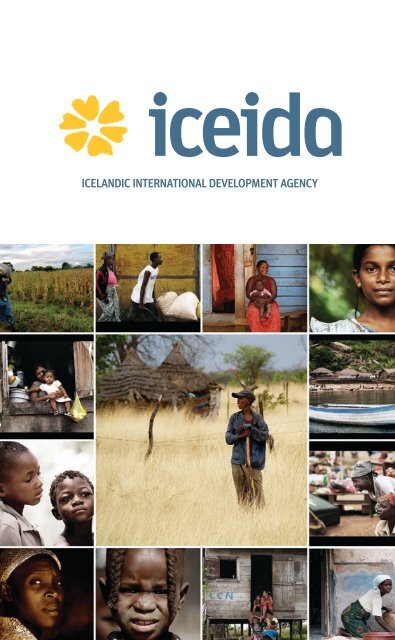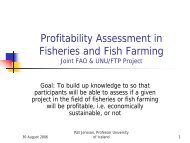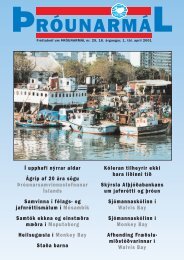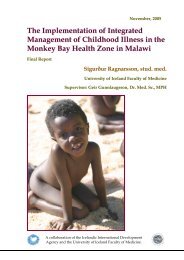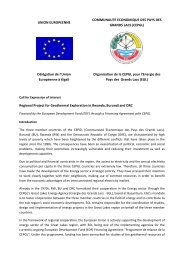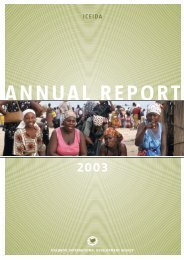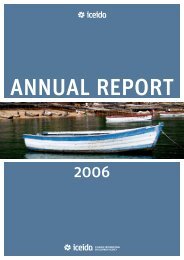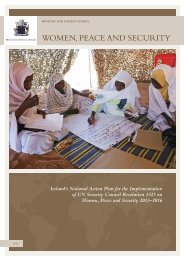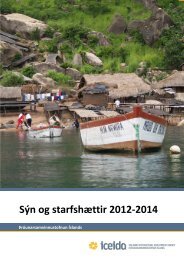Icelandic International Development Agency (ICEIDA)
Icelandic International Development Agency (ICEIDA)
Icelandic International Development Agency (ICEIDA)
You also want an ePaper? Increase the reach of your titles
YUMPU automatically turns print PDFs into web optimized ePapers that Google loves.
<strong>Icelandic</strong> <strong>International</strong> <strong>Development</strong> <strong>Agency</strong> (<strong>ICEIDA</strong>)<br />
The aim of <strong>Icelandic</strong> development cooperation is to promote<br />
the reduction of poverty, increased economic growth and<br />
social development, sustainable use of natural resources and<br />
environmental issues.<br />
<strong>ICEIDA</strong> is a government institution under the auspices of<br />
the Ministry for Foreign Affairs and is responsible for the<br />
implementation of official <strong>Icelandic</strong> bilateral development<br />
cooperation. It follows the <strong>Icelandic</strong> government’s Act on<br />
<strong>Development</strong> Cooperation No 121/2008, which is in keeping<br />
with the UN Millennium <strong>Development</strong> Goals and other<br />
international commitments, such as the Monterrey Consensus<br />
on Financing for <strong>Development</strong> and the Paris Declaration on Aid<br />
Effectiveness. <strong>ICEIDA</strong> operates in line with the DAC Guidelines<br />
on development cooperation and its implementation. All<br />
of <strong>ICEIDA</strong>´s development cooperation is based on mutual<br />
international agreements between the government of Iceland<br />
and the governments of the partner countries.<br />
The Millennium <strong>Development</strong> Goals<br />
• Eradicate extreme poverty and hunger<br />
• Achieve universal primary education<br />
• Promote gender equality and empower women<br />
• Reduce child mortality<br />
• Improve maternal health<br />
• Combat HIV/AIDS, malaria and other diseases<br />
• Ensure environmental sustainability<br />
• Develop a global partnership for development<br />
2
How do we work?<br />
<strong>ICEIDA</strong>´s main objective is to reduce poverty and improve<br />
the quality of life among the poorest. It emphasises<br />
sustainable social and economic development with gender<br />
equality, human rights, democracy and environmental<br />
sustainability as a frame of reference. <strong>ICEIDA</strong> emphasises<br />
institutional support and capacity building.<br />
<strong>ICEIDA</strong>´s development cooperation is bilateral and based<br />
on a project-wide approach. Most project ideas originate in<br />
partner countries and are implemented in accordance with<br />
the requirements of the partner country, in the spirit of the<br />
government policy of the country in question. The objectives<br />
shall be in accordance with the partner country’s development<br />
strategies and their Poverty Reduction Strategy Papers.<br />
<strong>ICEIDA</strong> emphasises equal opportunity for all concerned and<br />
pursues the active participation of all stakeholders in the<br />
preparation and implementation of the projects. Working<br />
towards sustainability, <strong>ICEIDA</strong>´s strategies are intended<br />
to facilitate the ownership of the partner countries in all<br />
development projects. <strong>ICEIDA</strong> also stresses harmonisation<br />
of development activities, and takes into account the<br />
activities of other international development agencies and<br />
NGOs operating in the partner country. Furthermore, <strong>ICEIDA</strong><br />
promotes grassroots activities and supports NGOs, both<br />
<strong>Icelandic</strong> and local.<br />
4
Budget:<br />
In 2007, <strong>Icelandic</strong> ODA amounted to 0.25% of GNI, or 48.4<br />
million USD. Thereof, <strong>ICEIDA</strong>’s budget constitutes just over<br />
one third, or 17.4 million USD. Iceland is committed towards<br />
achieving the goal set by the United Nations of using 0.7% of<br />
GNI towards ODA.<br />
5
other 6%<br />
water/sanitation 5%<br />
geothermal 4%<br />
social 10%<br />
head office 10%<br />
fisheries 21%<br />
Distribution by<br />
sectors 2007<br />
education 31%<br />
health 13%<br />
Sri Lanka 7%<br />
Nicaragua 6%<br />
other 6%<br />
head office 10%<br />
Namibia 9%<br />
Distribution by<br />
countries 2007<br />
Uganda 14%<br />
Mozambique 21%<br />
Malawi 27%<br />
6
<strong>ICEIDA</strong>´s partner countries are six: Malawi, Mozambique,<br />
Namibia and Uganda in Africa, Sri Lanka in Asia and<br />
Nicaragua in Central America.<br />
7
Malawi<br />
<strong>Development</strong> cooperation between Iceland and Malawi<br />
started in 1989. At first, the focus was entirely on the<br />
fisheries sector but with time it has moved towards health<br />
and education. Most of <strong>ICEIDA</strong>´s activities are being<br />
carried out in the district of Mangochi in the southern part<br />
of the country. <strong>ICEIDA</strong>´s most extensive project in Malawi<br />
constitutes vast support to the Monkey Bay Health Zone,<br />
and includes support to the local hospital and its outreaches.<br />
<strong>ICEIDA</strong>´s support to education in the district is varied and it<br />
reaches out to primary schools, secondary schools, adult<br />
literacy and the district education office. An extensive<br />
water and sanitation project has also been launched in<br />
the district with the objective of promoting improved health<br />
among the local population, but water-related diseases<br />
are common. <strong>ICEIDA</strong>´s project within the fisheries sector<br />
promotes education and the development of small-scale<br />
fisheries towards sustainable resource utilisation.<br />
8
Population<br />
GDP per capita PPP<br />
Life expectancy at birth<br />
Adult literacy rate (age 15 and above)<br />
<strong>ICEIDA</strong> contribution in 2007<br />
13.1 million<br />
844 US$<br />
46.3 years<br />
64.1%<br />
4,594,143 US$<br />
9
Mozambique<br />
Iceland’s cooperation with Mozambique dates back to 1995.<br />
The main focus is on the fisheries sector. Transferring<br />
<strong>Icelandic</strong> expertise in fisheries research, management,<br />
quality assurance and institutional strengthening are the<br />
main pillars of <strong>ICEIDA</strong>´s activities, supporting the sustainable<br />
use of natural resources. <strong>ICEIDA</strong> is also engaged in projects<br />
in other sectors and cooperates with the <strong>Icelandic</strong> and the<br />
Mozambique Red Cross in the health sector in Maputo and<br />
Hindane provinces. Within the social sector <strong>ICEIDA</strong> has<br />
focused on capacity building with various kinds of support to<br />
the organisational infrastructure of the Ministry of Women<br />
and Social affairs. It is also engaged in projects in the<br />
education sector, supporting both primary education and<br />
adult literacy.<br />
10
Population<br />
GDP per capita PPP<br />
Life expectancy at birth<br />
Adult literacy rate (age 15 and above)<br />
<strong>ICEIDA</strong> contribution in 2007<br />
21 million<br />
804 US$<br />
42.8 years<br />
38.7%<br />
3,598,485 US$<br />
11
Namibia<br />
<strong>Development</strong> cooperation between Namibia and Iceland<br />
began in 1990, the same year that Namibia gained<br />
independence. To begin with, the cooperation was first and<br />
foremost in the fisheries sector, in the development of marine<br />
research and the education of fishermen. With time, the<br />
projects have been moving over to the social sector with<br />
special emphasis on supporting minority groups, with the<br />
two largest projects in Namibia being with the Himba and the<br />
Deaf. The projects with the Himba, nomads in the Northwestern<br />
part of Namibia, include support to kindergartens<br />
and adult literacy as well as drilling for water, building<br />
wells and grazing control. Support to the Deaf community<br />
is based on improving education for the Deaf with emphasis<br />
on strengthening Namibian Sign Language.<br />
12
Population<br />
GDP per capita PPP<br />
Life expectancy at birth<br />
Adult literacy rate (age 15 and above)<br />
<strong>ICEIDA</strong> contribution in 2007<br />
2.1 million<br />
5,182 US$<br />
51.6 years<br />
85%<br />
1,598,582 US$<br />
13
Uganda<br />
In 2000, a general agreement for development cooperation<br />
between Iceland and Uganda was signed. The project<br />
which receives most support from <strong>ICEIDA</strong> is a district<br />
development project carried out in the island district of<br />
Kalangala on Lake Victoria. The project’s aim is to support the<br />
district in achieving quality administration and management<br />
of public services, sustainable fisheries production, as well as<br />
equitable access for the hard-to-reach communities to quality<br />
education and health services. <strong>ICEIDA</strong> also supports adult<br />
literacy in the island districts of Mukono and Kalangala.<br />
Other projects include support for the Entrepreneurship<br />
Training Programme, where the immediate objective is to<br />
improve the access of Ugandan SME entrepreneurs to quality<br />
training and business skills. Furthermore, <strong>ICEIDA</strong> supports a<br />
project in the fisheries sector, with the quality assurance of<br />
fish products being the main objective.<br />
14
Population<br />
GDP per capita PPP<br />
Life expectancy at birth<br />
Adult literacy rate (age 15 and above)<br />
<strong>ICEIDA</strong> contribution in 2007<br />
29.9 million<br />
1.600 US$<br />
49.7 years<br />
66.8%<br />
2,508,682 US$<br />
15
Sri Lanka<br />
<strong>ICEIDA</strong>´s cooperation with Sri Lanka commenced in 2005.<br />
In compliance with the original request by Sri Lanka, the<br />
focus is on the fisheries sector with specific attention given<br />
to projects assisting in the recovery from the devastation<br />
caused by the tsunami in 2004. The largest project includes<br />
the infrastructure development and capacity building at<br />
32 landing centres in Sri Lanka. Other projects relate to<br />
aquaculture, fishing vessel registry, fisheries statistics and<br />
quality management in fisheries. It has been decided to<br />
terminate development cooperation with Sri Lanka as of<br />
2009.<br />
16
Population<br />
GDP per capita PPP<br />
Life expectancy at birth<br />
Adult literacy rate (age 15 and above)<br />
<strong>ICEIDA</strong> contribution in 2007<br />
19.3 million<br />
4.222 US$<br />
71.6 years<br />
90.7%<br />
1,225,908 US$<br />
17
Nicaragua<br />
<strong>ICEIDA</strong> opened its first office in Latin America, in Nicaragua<br />
at the beginning of 2006. The energy sector, in which<br />
<strong>Icelandic</strong> expertise is significant, constitutes the largest<br />
part of <strong>ICEIDA</strong>´s activities in Nicaragua. The emphasis is on<br />
the transference of knowledge for local use in geothermal<br />
energy, with the aim to enhance sustainable use of<br />
geothermal resources in the country. Activities within the<br />
social, education and health sectors have also been prepared<br />
and some initiated on the Atlantic coast of Nicaragua,<br />
where maternal houses and primary schools have been<br />
supported.<br />
18
Population<br />
GDP per capita PPP<br />
Life expectancy at birth<br />
Adult literacy rate (age 15 and above)<br />
<strong>ICEIDA</strong> contribution in 2007<br />
5.68 million<br />
2,952 US$<br />
71.9 years<br />
76.7%<br />
1,123,282 US$<br />
19
Iceland<br />
Iceland is Europe’s westernmost country, the second largest<br />
island in Europe, located in the North Atlantic Ocean (a<br />
little over 3 hours flight from London, Paris, Amsterdam or<br />
Copenhagen and 5 ½ hours from New York). The capital city<br />
is Reykjavík.<br />
The first settlers came to Iceland from Norway and Ireland in<br />
the 9th century. The Althingi, the world’s oldest functioning<br />
legislative assembly, was established in the year 930 AD.<br />
Akureyri<br />
Reykjavik<br />
20
• Total Area:<br />
• Landscape:<br />
• Sea area within fishing limits:<br />
• Temperature:<br />
• Population:<br />
• Population growth rate:<br />
• Religion:<br />
• Life Expectancy Rate:<br />
• HIV/AIDS prevalence:<br />
• Government:<br />
• GDP per capita PPP:<br />
• Unemployment rate:<br />
• Employment by industry:<br />
103,000 km 2<br />
Vegetation 23.1%<br />
Lakes: 2.7%<br />
Glaciers: 11.6%<br />
Wasteland: 62.6%<br />
4,970 km 2<br />
2° Celsius (winter)<br />
11° Celsius (summer)<br />
312,900 (Reykjavik: 117,700)<br />
1%<br />
Freedom of religion;<br />
State Lutheran Church 84%<br />
81.5 years<br />
0.2%<br />
Republic since 17 June 1944<br />
Independent since 1 December 1918<br />
36,510<br />
2.3%<br />
Agriculture and fishing: 6.9%<br />
Industry: 20.7%<br />
Services: 73.1%<br />
22
address:<br />
Þverholti 14<br />
105 Reykjavík<br />
tel: 545 8980<br />
iceida@iceida.is<br />
www.iceida.is/english<br />
All data in this leaflet is from 2007<br />
Layout and design: Þórey Mjallhvít Ómarsdóttir<br />
Editorial staff: Gunnar Salvarsson and Þórarinna Söebech<br />
Photos: Gunnar Salvarsson<br />
Printing: GuðjónÓ<br />
ISBN: 978–9979–9808–1–0


